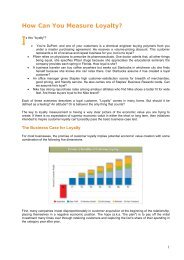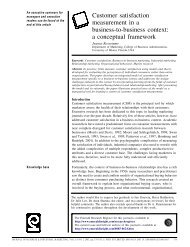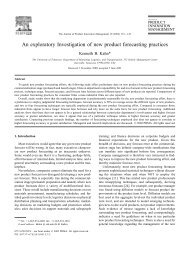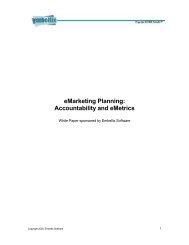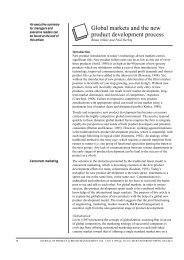The Executive's Guide to Branding
The Executive's Guide to Branding
The Executive's Guide to Branding
You also want an ePaper? Increase the reach of your titles
YUMPU automatically turns print PDFs into web optimized ePapers that Google loves.
lowers perceived risk and enhances loyalty. Lack of experience with a<br />
product leads <strong>to</strong> higher risk perceptions reducing the likelihood of that option<br />
being tried by consumers. Thus, in “experience” goods consumer often rely<br />
on the sellers’ expertise. In this case the sellers brand associations lead the<br />
consumer’s choice.<br />
Interestingly, while brand management practices are common in the<br />
consumer packaged goods industries, they can be expected <strong>to</strong> be even more<br />
valuable in product markets where experience and reliance on brand<br />
associations are even more critical in reducing risk and influencing choice.<br />
Thus firms offering high-risk “experiential” goods and firms in services<br />
industries should find branding very attractive. Service offerings (like finance,<br />
real estate, insurance, travel) and technology-based offers are great<br />
candidates for benefiting from superior brand management practices. For<br />
technology-based industries the rate of innovation is high and subsequently<br />
this makes the rate of uncertainty in the purchase decision high (such as risk<br />
of functional performance). And, that in essence makes branding<br />
fundamentally vital.<br />
5. Do strong brands lead <strong>to</strong> lower information costs in the purchase<br />
process?<br />
Lower information costs in the purchase process results in lower perceived<br />
risk. One approach <strong>to</strong> measuring brand equity is <strong>to</strong> decompose it in<strong>to</strong> two<br />
components: (1) a liking/emotional component, and (2) an information cost<br />
component. Because costs associated with making a choice among<br />
competing options include search and evaluation costs, strong brands that<br />
are more familiar and that have positive associations (e.g., quality) that are<br />
Zyman Institute of Brand Science – Perspectives 7




